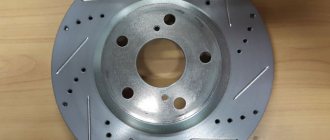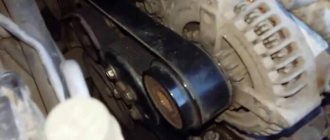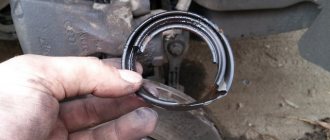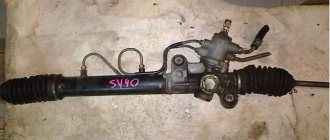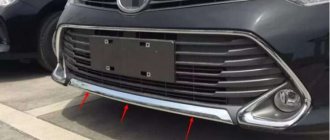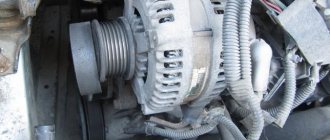Replacing brake pads on a Camry
Fundamentally, replacing brake pads on a Toyota Camry is no different from this procedure carried out on any other Japanese-made car. Depending on the year of manufacture and equipment of the car, several types of brake mechanisms on Camry differ, but in general they are not much different from each other.
Replacing brake pads on a Toyota Camry
The operation can be performed by car owners either independently or in a service center. Depending on the type of brakes, work can take from 1 to several hours.
Spare parts Toyota Camry V50, Toyota Camry V50 spare parts
The premiere of the current latest generation of the Toyota Camry V50 business class sedan took place at the Moscow Motor Show MMAC 2014. When designing the new product, 90% of spare parts and components were developed specifically for this model and only 10% were borrowed by engineers from the previous generation of the car. The main sales market is the USA, but the car has gained great popularity in the CIS countries and many Arab states.
The new product differs from its predecessor in its aggressive appearance, modified engine line-up and luxurious, comfortable interior. If you put the V40 and V50 side by side, you can see that these are completely different cars. The main changes affected the front end - now there is a narrow radiator grille, smoothly transitioning to new modern lensed optics with LEDs. A predatory bumper with a wide air intake hints at the sporty habits of the sedan. The dimensions of the body have not changed much, but you won’t find the smooth lines of the previous generation car here - the Camry has again become “chopped”. When looking at the car from the side, one notices the elegant side mirror housings with built-in LED turn signal repeaters and large wheel arches, in which the standard wheels do not seem entirely appropriate.
There are slightly fewer innovations in the rear of the car. Engineers slightly changed the shape of the rear bumper and lamp shades, adding LED modules to the latest ones. These touches not only added more aggression to the appearance of the Toyota Camry V50, but also reduced the aerodynamic drag coefficient, which was already outstanding for cars of this class. It is worth noting that the dimensions have remained almost unchanged: the length of the sedan is 4,850 mm, width is 1,825 mm, height is 1,480 mm.
The interior of the new product has definitely changed for the better. Instead of a bulky 4-spoke steering wheel, there is a neat 3-spoke steering wheel. The design of the wood-effect inserts, the center console and the automatic transmission selector has changed. Between the tachometer and speedometer dials there is a modern on-board computer display. The climate control unit has changed - the buttons have become larger, the backlight has changed.
As befits a business-class sedan, the Toyota Camry V50 in its expensive configuration is equipped with electric seats, mirrors and steering column with memory function, heated rear row of seats, a video monitoring system for blind spots, as well as the ability to wirelessly charge a smartphone or tablet.
Toyota Camry is the standard of safety. In addition to airbags, an injury-proof steering column and belt pretensioners, the car is already crammed with various “helpers” in the basic configuration. These include anti-lock braking system, electronic brake force distribution, brake assist and stability control.
The engine on the Camry V50 is started from a button, while the steering column and seat are in the position programmed by the driver. 3-zone climate control with air ionization function can maintain different temperature conditions for the driver, passenger and rear row.
For an additional fee, you can install a touch screen and a sophisticated navigation system.
The base engine is now a 4-cylinder 2-liter gasoline power unit with a VVT-i variable valve timing system. The power of the weakest engine in the line has increased to 150 hp, and the maximum torque of 199 Nm is achieved at 4600 rpm. It is paired with a 6-speed automatic transmission. This combination, of course, is not able to provide a heavy sedan with excellent acceleration dynamics. But for quiet city driving, this is an excellent option. Acceleration to “hundreds” takes just over ten seconds, and the top speed reaches 210 km/h. The developers left the other two engines (2.5 liters 181 hp and 3.5 liters 249 hp) unchanged.
Checking the condition of the pads
- Remove the front wheel of the previously raised and fixed part of the machine.
- Measure the thickness of the friction layer, which must be more than 1.50 mm, otherwise the brake pads must be replaced.
- At the same time, the “mirror” of the Camry V30 brake disc is checked. It must not contain defects in the form of stripes, chips, etc. If the latter are detected, the disk must be replaced or restored by turning and grinding on both sides, but only if the residual working thickness is at least 20.40 mm.
- Remove the rear wheel and drum. Please pay attention to the year of manufacture of the car.
- The thickness of the clutch must be at least 1.50 mm in the case of their fastening with glue and at least 0.50 mm in the case of riveted ones before fastening.
- At the same time, check the condition of the brake drum, the maximum diameter of which should be 281.00 mm.
You can purchase Toyota Camry pads at any specialized automotive store that sells spare parts. It is also possible to purchase using the Internet and order home delivery. Buy pads Toyota_04466-06090, Raybestos_PGD1212C, ACDelco_17D1212CH, Wagner_ZD1423, you can also choose similar ones.
the rules are really the same
to search, first, and then ask questions.
If you don’t have a photo of the report, take it yourself and post it on the forum.
Please buy a maintenance book
Rules of any forum: “If you can’t help, don’t answer.”
and how long does it take to change the pads?? I’ve already done 55, so I can’t hear the clang of metal))
Yesterday I changed it once and for the first time, everything is simple. at first it was))) ended in success. remove the wheel from the inside of the hub, unscrew the two 14mm bolts, remove the caliper, hang it from the spring (using a wire) or place it on the disc (whichever is convenient). Remove the old pads and put new ones in their place. “I took out the caliper guides and lubricated them (removing the old grease) - but this is not necessary if nothing is stuck.” New beautiful pads were installed. and here is the main problem. the caliper is not included in them; here you need either a special device that can press the release cylinder of the caliper or ingenuity)))) in general, with improvised means, we managed to do everything without special tools; in the end, I changed the pads on one wheel for an hour, on the second for 10 minutes))) the main thing is to release the caliper ))) when you press the second caliper, watch the brake fluid level - it may overflow (it got to the lid for me). I lubricated the pad guides and anti-squeak plates with a copper-containing lubricant (can be aluminum) so that there would certainly be no extraneous sounds... and THE MOST IMPORTANT AFTER STARTING THE ENGINE IS TO PRESS THE BRAKE PEDAL SEVERAL TIMES (4-5), THE PADS MUST FIT IN PLACE OTHERWISE. EVERYTHING CAN TURN INTO SHARDS)))). Today I rode, happy with my work))) I hope you will also enjoy the results of yours. Good luck.
Description and technical specifications
Front brake disc:
| Parameter | Magnitude | Unit |
| New brake disc thickness | 28,0 | millimeters |
| Brake disc thickness (minimum permissible) | 25,0 | millimeters |
| Product diameter | 296,0 | millimeters |
| Center hole diameter | 62,0 | millimeters |
| Number of holes for installing bolts | 5 | things |
| Weight | 7,3 | kilogram |
| Departure | 49,3 | millimeters |
| Maximum disc runout value | 0,05 | millimeters |
Rear brake disc:
| Parameter | Magnitude | Unit |
| New brake disc thickness | 10,0 | millimeters |
| Brake disc thickness (minimum permissible) | 8,5 | millimeters |
| Product diameter | 281,0 | millimeters |
| Number of holes for installing bolts | 5 | things |
| Weight | 4,7 – 5,0 | kilogram |
| Maximum disc runout value | 0,15 | millimeters |
My account
Replacing the rear cable of a Camry 40 To replace the rear cable, the car owner needs to use the instructions given below. Check the brake position when released.
Remove the spacer plate along with the spring. Remove the retainer spring, spring seats and retainer.
Toyota Camry XV40 Toyota Camry 2007 2.4 Replacing rear brake pads
Disconnect the return spring and remove the front pad. Remove the return spring from the rear shoe.
Disconnect the parking brake cable from the parking brake lever. Removing the parking brake lever Remove the lock washer and the parking brake lever fig. Check the removed parts for wear, rust or damage. Attach the return spring to the back of the rear brake pad.
Attach the return spring to the back of the front brake pad. Install the adjusting bar between the brake pads.
Install the brake pads onto the brake shield and install the pad carrier and spring. Install the front brake pad return spring.
Install the rear brake pad return spring. Install the rear brake pad spring and retainer. Install the front brake pad spring and retainer.
Correct placement of handbrake parts on the brake shield.
Review of the most popular campaign offers from brake disc manufacturers
When planning to buy brake discs for a Toyota Camry v40, almost every car owner asks a rather trivial question: “Which manufacturer campaigns offer truly high-quality products.” The main selection criteria, as a rule, are reasonable price and positive reviews from specialists. The question of how to improve the existing performance characteristics of the braking system is also relevant.
An analysis of this market segment shows a stable demand for products from such manufacturers as the German “TRW”, “Bosch”, “Delphi”, the Dutch “Nipparts” or the Japanese “Nibk”. There are also many supporters of brake discs in the “original” category.
The table below, based on monitoring the offers of the most popular campaigns - manufacturers, will provide the consumer with the necessary primary information, which is for reference only:
4200
3500
| Manufacturer's name | Item number | Estimated cost, rubles | Quantity and installation location |
| Delphi | BG4192 | 4140 – 4380 | 2 pcs. front |
| Delphi | BG4268 | 3940 – 4100 | 2 pcs. rear |
| TRW | DF4828S | 2 pcs. front | |
| TRW | DF6176 | 3980 – 4100 | 2 pcs. rear |
| Nibk | RN1241 | 4900 – 5060 | 2 pcs. front |
| Nibk | RN1432 | 2 pcs. rear | |
| Nipparts | 3302164 | 3940 – 3960 | 2 pcs. front |
| Nipparts | 3312070 | 2180 – 2200 | 2 pcs. rear |
| Bosch | 0986478968 | 4680 – 4780 | 2 pcs. front |
| Bosch | 0986479R06 | 2260 – 2340 | 2 pcs. rear |
| Toyota Motors | 4351233140 | 4580 – 4730 | 2 pcs. front |
| Toyota Motors | 4243133130 | 3200 – 3350 | 2 pcs. rear |
Disc brake repair
Replacing the front brake pads on a Toyota Camry is performed as follows:
- The car is jacked up and the wheel is removed.
- Then the lower bolt of the caliper bracket is unscrewed, after which it is turned upward, freeing the system elements.
- Then the pad installed on the back side of the disc is pulled out, after which the mounting is installed in the hatch located in the caliper.
- Acting as a lever, you need to completely compress the brake cylinder.
- Then the outer pads are installed, after which the caliper bracket is pushed into place and screwed.
- The wheel is put on, the car is removed from the jack.
Useful tips
The pads on the Camry 50 must be replaced when worn. Parts need to be replaced only as a complete set, otherwise braking efficiency will be significantly reduced.
Before installing new consumables, it makes sense to pump out some of the liquid from the tank to prevent overflow. It is easy to press the piston into the cylinder using a screwdriver inserted between the piston and the inner lining.
After updating the pads on the Camry 50, you need to drive carefully so that the parts get used to each other. During the first 100 km, the brake efficiency may be reduced.
Signs of worn brakes
The wear of mechanisms on Rav 4 can be determined by the following signs:
- when braking, a characteristic squeal and a beating is felt (the reason is uneven wear of the pads and discs);
- braking distance increases;
- deceleration occurs too late or too quickly (weak or harsh brakes indicate that it is time to change parts);
- There is visible carbon deposits or metal dust on the wheel (the lining is scratched).
If you notice signs of wear, do not delay replacement, as the risk of an accident increases significantly if the brakes are ineffective.
Additional Information
Fans of a sporty driving style, as well as adherents of aggressive driving, can recommend brake discs from the DBA campaign, manufactured using Thermal Stability Profiling technology, which provides the following operational advantages:
- The unique structure of the material ensures the resistance of the working surface to the effects of deformation processes.
- Immunity to the effects of sudden (prolonged) braking.
- Quick “grinding in” of working surfaces.
Features of Rotinger products
Rotinger brake discs, suitable for Toyota Camry 40 , have special notches and perforations, which ensures better contact with the pads and reduces the risk of overheating during operation. The products are made of high-carbon steel, capable of withstanding not only high temperatures, but also sudden changes. They can happen, for example, when a car gets into a deep puddle at high speed.
Perforation serves for rapid cooling and helps clean the system from road dust and dirt. The diameter is 296 mm, the height is 49.3 mm, the product is designed for a 62 mm hub.
The thickness of the new part is 28 mm; the disk must be changed at a nominal thickness of 25 mm. The thread is 14.50 mm.
